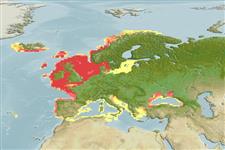Environment: milieu / climate zone / rango de profundidad / distribution range
Ecología
marino; salobre bentopelágico; oceanodromo (Ref. 51243); rango de profundidad 10 - 200 m (Ref. 1371), usually 30 - 100 m (Ref. 1371). Temperate; 72°N - 35°N, 27°W - 42°E
Northeast Atlantic: southeastern Barents Sea and Iceland to Portugal, also in the Black Sea, Aegean Sea, Adriatic Sea and adjacent areas. Rare in the northwestern Mediterranean.
Length at first maturity / Tamaño / Peso / Age
Madurez: Lm 28.2, range 28 - 30 cm
Max length : 91.5 cm TL macho / no sexado; (Ref. 106276); common length : 23.5 cm TL macho / no sexado; (Ref. 1371); peso máximo publicado: 3.1 kg (Ref. 40637); edad máxima reportada: 20 años (Ref. 35388)
Espinas dorsales (total) : 0; Radios blandos dorsales (total) : 30 - 40; Radios blandos anales: 30 - 35. Body elongate; head small. Chin barbel small or absent. Lateral-line canals on head with pores. Color is variable; yellowish-brown, dark blue or green, sides yellowish grey, white and silvery on belly; often with a small dark blotch at the upper base of the pectoral fin.
Body shape (shape guide): fusiform / normal; Cross section: circular.
More commonly found from 30 to 100 m, mainly on mud and gravel bottoms, but also on sand and rock. Feed on shrimps, crabs, mollusks, small fish, polychaetes and cephalopods. Migrate to the open sea only after the first year of life. Eggs are pelagic. Larvae and juveniles are associated with jellyfish. Upon maturity, small chin barbel characteristic of juveniles disappear (Ref. 53061). Spawn in batches (Ref. 51846). Utilized fresh, dried or salted, smoked and frozen; eaten steamed, broiled and baked (Ref. 9988).
Oviparous, sexes are separate (Ref. 205).
Cohen, D.M., T. Inada, T. Iwamoto and N. Scialabba, 1990. FAO species catalogue. Vol. 10. Gadiform fishes of the world (Order Gadiformes). An annotated and illustrated catalogue of cods, hakes, grenadiers and other gadiform fishes known to date. FAO Fish. Synop. 125(10). Rome: FAO. 442 p. (Ref. 1371)
IUCN Red List Status (Ref. 130435: Version 2025-1)
Threat to humans
Harmless
Human uses
Pesquerías: muy comercial; pesca deportiva: si; Acuario: Acuarios públicos
Herramientas
Special reports
Download XML
Fuentes de Internet
Estimates based on models
Preferred temperature (Referencia
123201): 7 - 11.9, mean 9.2 °C (based on 409 cells).
Phylogenetic diversity index (Referencia
82804): PD
50 = 1.0000 [Uniqueness, from 0.5 = low to 2.0 = high].
Bayesian length-weight: a=0.00617 (0.00547 - 0.00695), b=3.06 (3.02 - 3.10), in cm total length, based on LWR estimates for this species (Ref.
93245).
Nivel trófico (Referencia
69278): 4.4 ±0.2 se; based on diet studies.
Generation time: 5.3 (4.4 - 6.8) years. Estimated as median ln(3)/K based on 23
growth studies.
Resiliencia (Referencia
120179): Medio, población duplicada en un tiempo mínimo de 1.4-4.4 años (rm=1.1-1.6(?); K=0.07-0.74; tm=1-4; tmax=20; Fec>100,000).
Prior r = 0.49, 95% CL = 0.33 - 0.74, Based on 20 full stock assessments.
Fishing Vulnerability (Ref.
59153): High to very high vulnerability (67 of 100).
🛈
Climate Vulnerability (Ref.
125649): Moderate to high vulnerability (47 of 100).
🛈
Nutrients (Ref.
124155): Calcium = 18 [9, 36] mg/100g; Iron = 0.2 [0.1, 0.6] mg/100g; Protein = 18 [16, 20] %; Omega3 = 1 [0, 2] g/100g; Selenium = 17.8 [8.2, 36.9] μg/100g; VitaminA = 11.9 [3.0, 48.0] μg/100g; Zinc = 0.242 [0.129, 0.709] mg/100g (wet weight); based on
nutrient studies.
